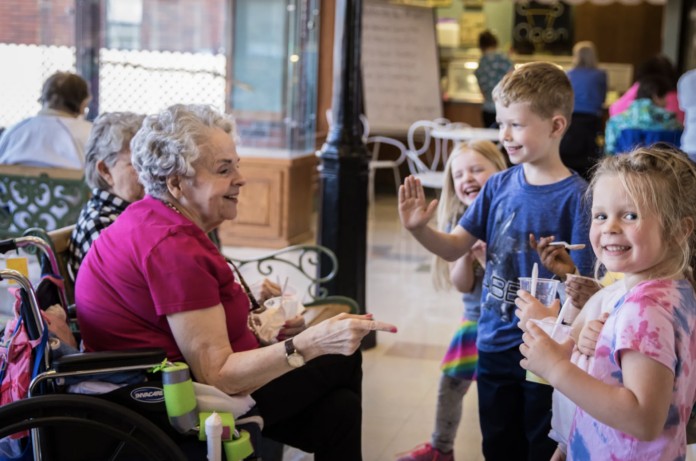“All in Together: Creating Places Where Young and Old Thrive,” by advocacy group Generations United and the Eisner Foundation, examines the growth in shared sites, defined as facilities, schools, and senior living centers that promote intergenerational activity and bonding, from seniors and college students living in the same housing to preschools attached to retirement communities. “We have an aging population, and what we can’t afford to do is set them in a Sun City-type arrangement so they’re only sharing their experience and knowledge with other older adults,” says Donna Butts, executive director of Generations United.
It may be assumed that the most important benefit of giving seniors and children more chances to interact is countering social isolation among seniors. A study by Cigna found that U.S. adults are reaching “epidemic levels” of loneliness (article originally published in 2018). But senior isolation should be viewed as part of a society-wide problem stretching across age groups. The same Cigna report found that younger generations felt much lonelier than older ones, and a British study from this spring found that the highest proportion of people who felt “always or often lonely” were ages 16 to 24.
Multigenerational living is much more common in Asia and Europe, underscoring how the modern U.S. lifestyle, and our push toward sprawl, suburbia, single-family homes, and senior-only housing, has created a generational divide. The recent rise in multigenerational living in the U.S. has primarily been fueled by changing economic circumstances and increasing cultural diversity and immigration. Many people who come together by necessity are staying together by choice. There’s an increasing awareness of a lifestyle that brings different generations together under the same roof.
Shared intergenerational spaces also help dispel fears and stereotypes. A recent study of senior housing providers found that many “saw intergenerational programming as a way for older adults to gain a greater understanding of the children and young adults in their communities”.
Polling found that 94 percent agree older people have skills and talents that can help address children’s needs, and 89 percent believe the inverse, that children can help older adults. More than 62 percent believe that senior centers and schools should find ways to get children and seniors to interact more. But just 26 percent of Americans “are aware of places in their community that care for children/youth and older adults together.”
”So often people separate the care of elders and small children, when more research shows that both of these so-called ‘book-end’ generations benefit from being together, especially in structured programs,” says Dwayne Clark, CEO of Aegis Living. “The smiling faces of children bring vibrancy and fun, which energizes seniors.” According to Butts, having seniors volunteer and interact with children helps teach children important soft skills. Different activities, such as trips outside or storytelling, often tie back to school curriculum. “It really starves our society and our culture, our next generation, if we isolate seniors. They can and want to continue to contribute.”
Analysis
This article explains the numerous mutual benefits of fostering social connections between older and younger generations- reminiscent of another thesis project that was completed a few years ago. It emphasizes that older adults have a lot of wisdom and experience that can be shared with young children who are learning about the world, while young children can help older generations gain a greater understanding of the youth in their neighborhood and are full of curiosity and fun, which can energize older adults. It also references the concept of multigenerational housing, something that the article acknowledges as being common in Europe and Asia, but has only recently gained prevalence in the United States. The relationships that form between younger children and older adults seems very natural, especially considering their benefit to both parties. This article serves as a reminder to look for niches in which older adults could fill a need in the community. It’s possible that a solution could include older adults doing the providing, rather than only being provided for.




